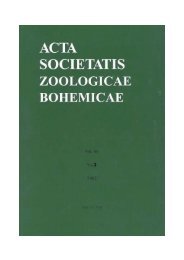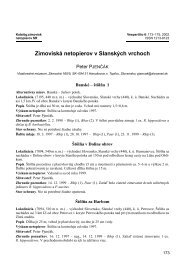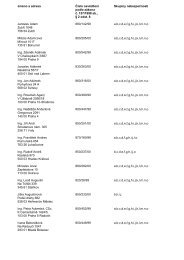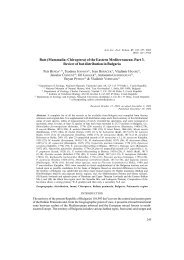Untitled
Untitled
Untitled
Create successful ePaper yourself
Turn your PDF publications into a flip-book with our unique Google optimized e-Paper software.
The recognition of terrestrial impact structures<br />
Figure 8. Photomicrograph of fused glass (lechatelierite), Ries, Germany,<br />
plane light, field-of-view = 2.5 mm.<br />
towards their lower and upper contacts. They may, therefore,<br />
have a textural resemblance to endogenic igneous<br />
rocks. Impact melts are superheated, reaching thousands<br />
of degrees Kelvin. Temperature differences with host<br />
rocks may result in rapid cooling of the melt leading to farfrom-equilibrium<br />
textures (Fig. 7). Grain-size in thick impact-melt<br />
sheets increases inwards from the contacts, but,<br />
in general, impact-melt rocks are usually fine-grained to<br />
glassy. An important textural property of impact-melt<br />
rocks is the presence of mineral and rock fragments, which<br />
have undergone shock metamorphism of different degrees,<br />
and have been variously reworked by the melt. The size of<br />
such fragments ranges from millimeters to several hundreds<br />
of meters, and gradational changes in inclusion content<br />
are observed in thick melt sheets, varying from one to<br />
several tens of percent (e.g. von Engelhardt 1984), with<br />
highest concentrations towards their lower and upper contacts.<br />
Impact-melt rocks can have an unusual chemistry compared<br />
with endogenic volcanic rocks, as their composition<br />
depends on the wholesale melting of a mix of target rocks,<br />
as opposed to partial melting and/or fractional crystallization<br />
relationships for endogenous igneous rocks. The composition<br />
of impact-melt rocks is characteristic of the target<br />
rocks and may be reproduced by a mixture of the various<br />
country rock types in their appropriate geological proportions.<br />
Such parameters as 87 Sr/ 86 Sr and 143 Nd/ 144 Nd ratios<br />
may also reflect the pre-existing target rocks within the<br />
impact-melt rocks composition (Jahn et al. 1978, Faggart<br />
et al. 1985). In general, unlike endogenous magmatic rock<br />
masses of comparable size (up to a few hundred meters<br />
thick), even relatively thick impact-melt sheets are chemically<br />
homogeneous over distances of millimeters to kilometers.<br />
In cases where the target rocks are not<br />
homogeneously distributed, this observation may not hold<br />
true, such as for Manicouagan, Canada (Grieve and Floran<br />
1978), Chicxulub (Kettrup et al. 2000) and Popigai (Kettrup<br />
et al. 2002). Differentiation is not a characteristic of<br />
relatively thick coherent impact-melt sheets (with the exception<br />
of the extremely thick, ~ 2.5 km, Sudbury Igneous<br />
Complex, Sudbury Structure, Canada; Ostermann 1996,<br />
Ariskin et al. 1999, Therriault et al. 2002).<br />
Enrichments above target rock levels in siderophile elements<br />
and Cr have been identified in some impact-melt<br />
rocks. These are due to an admixture of up to a few percent<br />
of meteoritic material from the impacting body. In<br />
some melt rocks, the relative abundances of the various<br />
siderophiles have constrained the composition of the impacting<br />
body to the level of meteorite class, (e.g. East<br />
Clearwater, Canada, was formed by a C1 chondrite, Palme<br />
et al. 1979). In other melt rocks, no siderophile anomaly<br />
has been identified. This may be due to the inhomogeneous<br />
distribution of meteoritic material within the impact-melt<br />
rocks and sampling variations (Palme et al.<br />
1981) or to differentiated, and, therefore, relatively nonsiderophile-enriched<br />
impacting bodies, such as basaltic<br />
achondrites. More recently, high precision osmium-isotopic<br />
analyses have been used to detect a meteoritic signature<br />
at terrestrial impact structures (e.g. Koeberl et al.<br />
1994). Unfortunately, Re-Os systematics are, in themselves,<br />
not an effective discriminator between meteorite<br />
classes.<br />
Fused glasses and diaplectic glasses<br />
In general, shock fused minerals are characterized<br />
morphologically by flow structures and vesiculation (Fig.<br />
8). Peak pressures required for shock melting of single<br />
crystals are in the order of 40 to 60 GPa (Stöffler 1972,<br />
1974), for which postshock temperatures (> 1000 °C) exceed<br />
the melting points of typical rock-forming minerals<br />
(Fig. 5). At these conditions, the minerals in the rock will<br />
melt immediately and independently after the passage of<br />
the shock wave. This melt has approximately the same<br />
composition as the original mineral before any flow or<br />
mixing takes place, and the melt regions are initially distributed<br />
through the rock in the same manner as the original<br />
mineral grains (French 1998). Melting is mineral<br />
selective, producing unusual textures in which one or more<br />
minerals show typical melting features; whereas, others,<br />
even juxtaposed ones, do not. One of the most common<br />
fused glasses observed at terrestrial impact structures is<br />
that of quartz, i.e. lechatelierite (e.g. Fig. 8).<br />
Conversion of minerals to an isotropic, dense, glassy<br />
phase at peak pressures of 30 to 50 GPa (Fig. 5) and temperatures<br />
well below their normal melting point is a shock<br />
metamorphic effect unique to framework silicates. These<br />
phases are called diaplectic (from the Greek “destroyed by<br />
striking”) glasses, which are produced by breakdown of<br />
long-range order of the crystal lattice without fusion.<br />
Although diaplectic forms may occur as the direct result of<br />
compression by the shock wave, they are probably more<br />
commonly produced by inversion from a high-pressure<br />
crystalline phase, which is unstable in the postshock P-T<br />
environment (Robertson 1973). Based on shock recovery<br />
experiments, the formation of diaplectic glass occurs between<br />
30 and 45 GPa for feldspar and 35 to 50 GPa for<br />
quartz (e.g. Stöffler and Hornemann 1972). The morphology<br />
of the diaplectic glass is the same as the original mineral<br />
crystal and shows no evidence of fluid textures (e.g.<br />
Grieve et al. 1996). Diaplectic glasses have densities low-<br />
259








